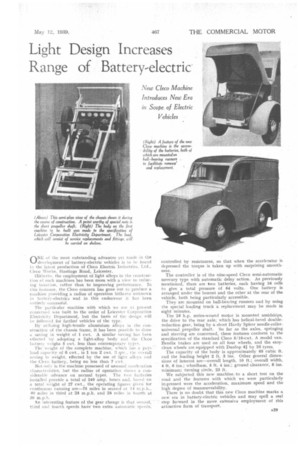Light Design Increases Range of Battery-electric
Page 31

If you've noticed an error in this article please click here to report it so we can fix it.
New Cleco Machine Introduces New Era in Scope. of Electric Vehicles ONE of the most outstanding advances yet made in the development of battery-electric vehicles is to be found in the latest production of Cleco Electric Industries, Ltd., Clew Works, Hastings Road, Leicester.
Hitherto, the employment of light alloys in the construction of such machines has been more with a view to reducittg taxation, rather than to improving performance. In this instance, the Cleco concern has gone out to produce a machine providing a radius of operation hitherto unknown in battery-electrics and in this endeavour it has been entirely successful.
The particular machine with which we are at present concerned was built to the Order of Leicester Corporation Electricity Department, but the basis of the design will be followed for further vehicles of the type.
By utilizing high-tensile aluminium alloys in the construction of the chassis frame, it has been possible to show a saving in weight of 1 cwt. A similar saving has been effected by adopting a light-alloy body and the Cleco battery weighs 5 cwt. less than contemporary types.
The weight of the complete machine, which has a payload capacity of 6 cwt., is 1 ton 2 cwt. 3 qrs., the overall saving in weight, effected by the use of light alloys and the Glee() battery, being no less than 7 cwt.
Not only is the machine possessed of unusual acceleration characteristics, but the radius of operation shoe s a considerable advance on normal types. The two batteries installed provide a total of 290 amp. hours and, based on a total weight of 27 cwt., the operating figures given for continuous running are-75 miles in second at 14 m.p.h., 40 miles in third at 24 m.p.h. and 24 miles in fourth at 30 m.p.h.
An interesting feature of the gear change is that second; third and fourth speeds have two extra automatic speeds; controlled by resistances, so that when the accelerator is depressed the torque is taken up with surprising smoothness.
The controller is of the nine-speed Cleco semi-automatic mercury type with automatic delay action. As previously mentioned, there are two batteries, each having 16 cells to give a total pressure of 64 volts. One battery is arranged under the bonnet and the other at the rear of the vehicle, both being particularly accessible.
They are mounted on ball-bearing runners and by using the special loading truck a replacement may be made in eight minutes.
The 24 h.p. series-wound motor is mounted amidships, the drive to the rear axle, which has helical-bevel doublereduction gear, being by a short Hardy Spicer needle-rolleruniversal propeller shaft. So far as the axles, springing and steering are concerned, these features conform to the specification of the standard Cleco 5/10-cwt. A model van. Bendix brakes are used on all four wheels, and the easyclean wheels are equipped with Dunlop 41 by 16 tyres.
The capacity of the body is approximately 65 cubic ft and the loading height 2 ft. 3 ins, Other general dimensions of interest are—overall length, 10 ft.; overall width, 4 ft. 6 ins.; wheelbase, 6 ft. 4 ins.; ground clearance, 8 ins. minimum; turning circle, 23 ft.
We subjected this new machine to a short test on the road and the features with which we were particularly impressed were the acceleration, maximum speed and the high degree of manceuvrability. There is no doubt that this new Cleco machine marks a new era in battery-electric vehicles and may spell a real step forward in the more extensive employment of this attractive form of transport.














































































